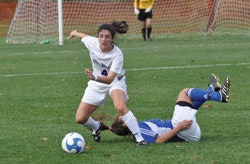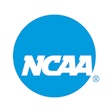A new study backs the intuitive path to Directors' Cup success - broad-based athletics sponsorship.
 SUCCESSFUL RUN Largely on the strength of its women's sports programs, Williams College has captured 11 consecutive Division III Directors' Cups.
SUCCESSFUL RUN Largely on the strength of its women's sports programs, Williams College has captured 11 consecutive Division III Directors' Cups.When Heather Lawrence was being recruited to dive competitively at the college level in the mid-1990s, she ultimately chose a school that many casual observers might classify as a football factory - the University of Florida, with its stadium affectionately called The Swamp and a fan base that revels in performing the Gator Chomp. But Lawrence knew better.
"One of the reasons I went there is because I knew that I was going to have a very similar experience to the rest of the athletes, because that was Florida's philosophy," says Lawrence, who would go on to earn bachelor's, master's and doctoral degrees from the university. "Not the same experience, but I wasn't going to feel like a second-class citizen."
The Florida philosophy of spreading its wealth among a wide variety of athletics programs to the benefit of both male and female student-athletes is a main reason the school perennially places among the top 10 finishers in the Learfield Sports Directors' Cup, the annual ranking of athletic departments based on their teams' performance. That philosophy is also relatively rare in Division I, where football and men's basketball often garner the lion's share of resources to the detriment of other sports.
According to a new study conducted by Lawrence, now an assistant professor of sports administration at Ohio University, widespread resource allocation is by far the biggest factor in determining how Division I Directors' Cup rankings shake out. "NCAA and NAIA Directors' Cup Standings: Predictors of Success," co-authored by Lawrence, Ming Li, John Regas and Jon Kander, examines 47 independent variables related to athletics administration in each of the NCAA's three divisions and the NAIA to see what influence overall spending has on Cup results, whether particular areas of spending stand out, whether coaching variables have an impact and if different predictors exist for each of the four subgroups. The researchers relied on data reported by 385 schools per the Equity in Athletics Disclosure Act.
In the end, Division I produced the single strongest success determinant, with total expenses per team for all women's sports (except football and basketball combined) accounting for more than half (58.4 percent) of the predictability of total points within the NCAA's premier division. This same variable topped the list in Division II, though with much less weight (16.2 percent). In Division III, women's participation combined with salaries of coaches of women's teams to predict 22.1 percent of total points.
The results serve to re-emphasize one of the stated goals of the Directors' Cup parent organization, the National Association of Collegiate Directors of Athletics, which established the program in 1993 to honor "institutions maintaining a broad-based program, achieving success in many sports, both men's and women's." That the influence of women's sports expenditures skewed higher in Division I as a Cup success predictor exposes the division's unrivaled emphasis on men's sports. This, in turn, opens the Directors' Cup door to Division I schools with historically underachieving football programs but abundant women's participation. Says Lawrence, "If you've limited your offerings because you're investing heavily in a couple of sports, then you're not giving yourself the chance to score points, whereas some other school may be able to."
Stanford, which sponsors 16 men's sports programs compared to 19 for women, has not surrendered the Division I Cup (which factors a school's top 10 performing men's teams and top 10 women's teams) since the university won its first in 1995. "They could score in more sports than they're allowed to count," Lawrence says. "Because they offer so many, they get to choose."
No one can fault Division I schools for focusing on football and men's basketball. After all, the NCAA bylaw outlining the division's philosophy clearly states that both sports should be "spectator-oriented" and "income-producing." But success in those sports alone can't guarantee Directors' Cup dominance, as was evidenced as recently as 2006-07. That year, Lawrence's alma mater became the first school in history to concurrently hold both the football and men's basketball national championships, yet Florida ranked no higher than sixth in the final Directors' Cup standings. Moreover, existing research has found there to be no relationship between operational spending on football and basketball and increases in winning, revenue generation or alumni giving.
Divisions II and III philosophy statements make no reference to spectators or revenue, the OU study authors point out, but finances are still a driver in predicting Directors' Cup success at those levels. Even in the NAIA, which may amount to a mere blip on the average fan's college sports radar, "it's really how much you spend," says Lawrence. "The more you spend and how much you spend per team were the two big factors that predicted [NAIA Directors' Cup success]."
When asked how important such success truly is, Lawrence says, "I think this is less important to the top 50 Division I schools and more important to the others. When you're on TV 400 times a year anyway, it doesn't matter if you have a press release that says you were 30th in the Directors' Cup. But if you're a Division II school that might only get on one NCAA highlight show for 30 minutes with 20 other schools, but you have a press release that says you were top five in the Directors' Cup, that's a big deal recruiting-wise. If you aren't one of the biggies, everything else becomes more important."
With the Directors' Cup scoring season heading into the home stretch (2009-10 winners will be announced in June), it's not likely that there's anything an athletics administrator can do at this point to give his or her school an extra kick to the finish line. It's not entirely clear a winning strategy can be devised for any given year. "We don't sit in a room and try to place our resources in spots that will help us win the Directors' Cup," Harry Sheehy, athletic director at perennial Division III Directors' Cup favorite Williams College, told AB four first-place finishes ago (see "Do the Right Thing"). "We try to take the resources we have and allocate a fair amount to each program in order for that program to provide an opportunity for our student-athletes to achieve excellence."
Upon hearing the quote, Lawrence adds, "I think that's exactly what Division III does."
The same can be said for select schools at every level. "The cool thing about the Directors' Cup, in my mind, is that it's rewarding broad-based programs," Lawrence says. "Everything else in athletics rewards wins. We found some indication that money was still a part of it, but not necessarily just money in football and men's basketball. For programs that do strive toward success in the Directors' Cup, it's an avenue to continue to stick to their own philosophy of broad-based support and participation."
Lawrence and her colleagues launched their Directors' Cup research hoping to answer a few simple questions: "Can we figure out how to win this thing? Is there a model that tells you what to do?" She found the results to be largely intuitive. "I feel like we don't have to do further research," Lawrence says. "Just do the right thing."

































